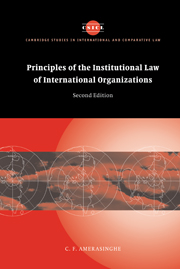Book contents
- Frontmatter
- Contents
- Preface
- List of abbreviations
- Table of cases
- 1 Introduction
- 2 Interpretation of texts
- 3 Legal personality
- 4 Membership and representation
- 5 Non-Judicial organs of organizations
- 6 Acts of non-judicial organs: their legal effect
- 7 Acts of non-judicial organs: the doctrine of ultra vires
- 8 Judicial organs
- 9 The internal law: employment relations
- 10 Privileges and immunities
- 11 Financing
- 12 Responsibility to and of international organizations
- 13 The liability of member states vis-à-vis third parties
- 14 Amendment of constitutions
- 15 Dissolution and succession
- 16 The settlement of disputes
- Index
- Cambridge Studies in International and Comparative Law
5 - Non-Judicial organs of organizations
Published online by Cambridge University Press: 10 December 2009
- Frontmatter
- Contents
- Preface
- List of abbreviations
- Table of cases
- 1 Introduction
- 2 Interpretation of texts
- 3 Legal personality
- 4 Membership and representation
- 5 Non-Judicial organs of organizations
- 6 Acts of non-judicial organs: their legal effect
- 7 Acts of non-judicial organs: the doctrine of ultra vires
- 8 Judicial organs
- 9 The internal law: employment relations
- 10 Privileges and immunities
- 11 Financing
- 12 Responsibility to and of international organizations
- 13 The liability of member states vis-à-vis third parties
- 14 Amendment of constitutions
- 15 Dissolution and succession
- 16 The settlement of disputes
- Index
- Cambridge Studies in International and Comparative Law
Summary
International organizations achieve their purposes and perform their functions primarily through organs. There is always at least one organ within an organization but generally there are many more than one. These organs are principal organs, such as the GA and the SC of the UN or the Board of Governors of the financial institutions, and subsidiary organs, such as committees, or the UNCTAD in the UN. They may be plenary, such as the GA of the UN or the Board of Governors of the financial institutions (e.g., the IBRD, the IMF, the ADB and the IDB), or of limited membership, such as the SC or the ECOSOC of the UN or the Executive Committee of the OECD. Some organs are administrative and executive, e.g., the secretariat of the UN, headed by the Secretary-General, or the secretariats of the specialized agencies of the UN, headed by the executive heads of the organizations (Director-Generals or Presidents, etc.), or the secretariat of the Council of Europe or the OECD. Generally, the organs of organizations belong to one of these categories.
There are also judicial organs which are generally principal organs, such as the ICJ or the CJEC, in whatever manner they are established, or have a special status, e.g., the IATs. Judicial organs will not be discussed in this chapter. Judicial organs which are established as organs by international organizations will be considered in Chapter 8.
- Type
- Chapter
- Information
- Publisher: Cambridge University PressPrint publication year: 2005

